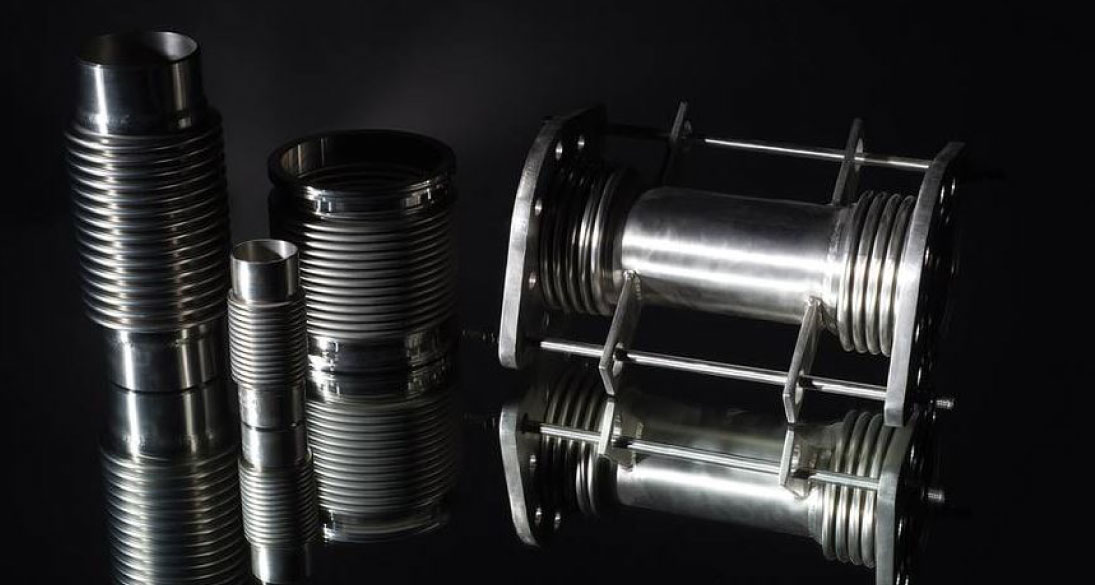Metal Expansion Joint Engineering
Senior Flexonics engineers, manufactures, and markets metal expansion joints and is recognized as the leader in the expansion joint industry. Our global leadership has been earned through consistent application of solid engineering principles, stringent quality standards, and product innovation to produce safe and reliable metal expansion joints for all types of piping applications.

Our skilled staff specializes in pipe motion technology and has an in-depth understanding of the critical nature of expansion joint applications. As the most experienced metal expansion joint manufacturer in North America, Senior Flexonics understands the demands that many customers face, and can offer solutions for pipe motion problems found in many industries.
Single Metal Expansion Joints – Offered in sizes ranging from 2″ to 144″
Single Metal Expansion Joints AS have one bellows. Axial compression and extension, lateral and angular movement can be accommodated. These metal expansion joints do not restrain the internal pressure thrust. The piping designer must provide the system with separate anchoring and guiding to resist the pressure thrust. Where small thermal movements are involved and proper anchoring and guiding is feasible, a single metal expansion joint is the most economical installation.
Tied Single AT Metal Expansion Joints also have one bellows, except the overall length is restrained by tie rods designed to contain pressure thrust. A tied single is usually designed for lateral offset so that the tie rods can remain fully engaged and loaded with the pressure thrust force. A two tie rod design can accept angular deflection in a single plane.
Metal Expansion Joints offered in sizes ranging from 2″ to 144″ in size. View our Single Expansion Joint reference guides.
Universal Metal Expansion Joints
Universal AU Metal Expansion Joints consist of two metal bellows separated by a pipe spool. This configuration accommodates large lateral movements, in addition to axial compression and extension and angular deflection. These metal expansion joints have no restraints to resist pressure thrust and like the singles, the piping designer must provide separate anchoring to handle pressure thrust.
Universal Tied, AUT Metal Expansion Joints contain two bellows separated by a pipe spool and tie rods designed to contain the pressure thrust force. These expansion joints are generally designed to accommodate lateral movement only. A universal expansion joint can be designed to have a very low lateral spring force to minimize forces on adjacent equipment. A two tie rod design can also accept angular deflection in a single plane.
The tie rods are usually at or near ambient temperatures and, therefore, do not expand and contract as a function of the temperature of the media within the pipe. As a result, the thermal expansion of the length of pipe between the tie rod end plates is forced into the bellows as an axial movement. The bellows design must accommodate this axial thermal expansion as well as the specified lateral movement.
Sometimes a universal expansion joint has a very heavy center spool that can exert excessive weight on the bellows elements. To protect the bellows elements from excessive lateral loads, a support system such as a slotted hinge can be installed across the individual bellows elements to support the dead weight of the center spool.
Hinged Metal Expansion Joints AH have a single bellows with overall length restrained by hinge hardware designed to accommodate pressure thrust. A hinged expansion joint allows angular movement in a single plane.
Universal Hinged AUH Metal Expansion Joints have two bellows separated by a pipe spool with overall length restrained by hinge hardware designed to contain pressure thrust. A hinged universal expansion joint accepts large lateral movements in a single plane with very low spring forces.
A three-hinge system can accommodate very large movements with very low reaction loads on the adjacent equipment. This is a very attractive application for large diameter hot piping systems if the movements are in the same plane.
Gimbal AG Metal Expansion Joints have a single bellows and gimbal hardware designed to resist pressure thrust. The gimbal expansion joint hardware operates like the universal joint on a drive shaft to accommodate angular movements in any plane.
Universal Gimbaled AUG Metal Expansion Joints are similar to the hinged universals except that the two expansion joints are gimbal type. The advantage of this arrangement is the ability of the expansion joint to accept large large lateral movements and independent angular movements in any plane.
A system consisting of two gimbals and a hinge can accommodate very large movements with very low reaction loads on the adjacent equipment. This is a very attractive application for large diameter hot piping systems even if the movements are complex and not in a single plane.
X Press Metal Expansion Joints
Pressure Balanced Metal Expansion Joints are devices which produce no pressure thrust forces in the piping system on the main anchors. In addition to eliminating the pressure thrust, the expansion joint can accept axial compression, axial extension, lateral and angular movements. The balancing thrust is created by using a balancing bellows.
Pressure Balanced Elbows are metal expansion joints which can consist of a single or double bellows in the flow section, and a balancing bellows of equal area on the back side of the elbow. Tie rods attach the outboard end of the balancing bellows to the outboard end of the flow bellows. Under pressure the tie rods are loaded with the pressure thrust force. If the flow bellows compresses in service, the balancing bellows extends the same amount without exposing the adjacent anchors to pressure thrust forces. However, the spring forces associated with bellows movements are imposed on the adjacent equipment. A pressure balanced elbow type expansion joint can accept axial compression, axial extension, lateral movements and very limited angular motion.
In-Line Pressure Balanced Metal Expansion Joints consist of single or double (universal) bellows to accept the piping induced axial compression, extension and lateral movements. An oversize bellows with approximately two times the area of the flow bellows is used to create an annular pressure chamber that produces a balancing pressure thrust force. Tie rods are used to link the bellows elements and contain the pressure thrust force. In-Line pressure balanced expansion joints are typically used in straight pipe runs between intermediate anchors (non pressure thrust resistant) or adjacent to rotating equipment that cannot operate with large externally applied loads.
